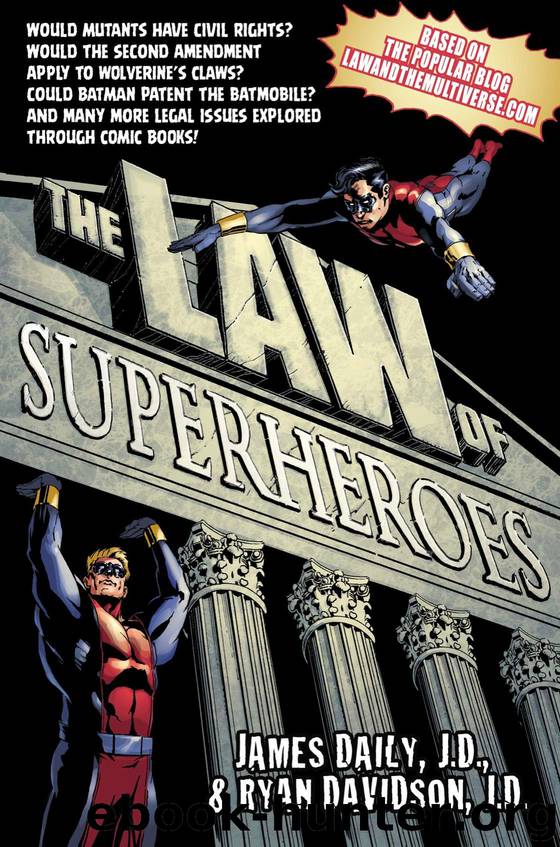The Law of Superheroes by James Daily & Ryan M. Davidson

Author:James Daily & Ryan M. Davidson
Language: eng
Format: mobi, epub
ISBN: 9781101600412
Publisher: Penguin Group US
Published: 2012-10-10T21:00:00+00:00
Of course, for some superheroes the question of involvement with a corporation is not a hypothetical one. The Fantastic Four, Bruce Wayne, and Tony Stark all have ties to companies, and this naturally raises questions about whether the superheroes’ actions could affect their respective businesses—and vice versa!
Superheroes and Respondeat Superior
Respondeat superior (“let the master answer”) is the legal doctrine by which employers can be held accountable for the torts of their employees under certain circumstances. 25 Specifically, the employee must be acting within the scope of his or her employment. 26 “An employee acts within the scope of employment when performing work assigned by the employer or engaging in a course of conduct subject to the employer’s control. An employee’s act is not within the scope of employment when it occurs within an independent course of conduct not intended by the employee to serve any purpose of the employer.” 27 This is a very important distinction, as it makes the difference between liability and non-liability for some superheroes.
For example, while Bruce Wayne often uses Wayne Enterprises resources when fighting crime as Batman, such crime fighting isn’t work assigned by his employer or subject to his employer’s control. In fact, most Wayne Enterprises employees and shareholders are, like the general public, unaware that Bruce Wayne is Batman. And while Batman may sometimes take actions that benefit Wayne Enterprises (e.g., preventing a criminal from stealing from the company), his motivation is to fight crime in general, not to benefit his employer. Thus, Wayne Enterprises is probably not liable for Batman’s torts. Which is good, because there are a lot of them.
The situation is very different when one considers DC’s recent Batman Incorporated title. Batman, Inc. is a recent effort by Batman to adopt a franchise model for Batman, funding various Batmen around the United States and the rest of the world. This presents a significant liability problem because Wayne Enterprises directly and publicly funds and equips these new Batmen, although Bruce Wayne’s identity as Batman is still a secret. Since Wayne Enterprises is providing the funding, equipment, and coordination, a court would likely view the Batmen as employees rather than independent contractors. 28 As a result, Wayne Enterprises has opened itself up to potentially massive liability. A more prudent approach would have been to create a separate nonprofit organization (not owned or controlled by Wayne Enterprises) that funds the Batmen; the intermediary organization would shield Wayne Enterprises from liability. Our next example actually follows that model.
When Tony Stark works with the Avengers as Iron Man, he isn’t there as an employee of Stark Industries, 29 nor does Stark Industries fund the Avengers directly. That’s the role of the Maria Stark Foundation, which functions as a liability shield. However, because the Avengers are themselves a corporate entity of some kind, the Avengers organization may be held liable for the torts of the individual Avengers if the torts were committed within the scope of the members’ employment. But at least liability would be effectively
Download
The Law of Superheroes by James Daily & Ryan M. Davidson.epub
This site does not store any files on its server. We only index and link to content provided by other sites. Please contact the content providers to delete copyright contents if any and email us, we'll remove relevant links or contents immediately.
Ready Player One by Cline Ernest(14530)
Warriors (9781101621189) by Young Tom(10746)
A Girl in a Million by Betty Neels(8648)
Red Rising by Pierce Brown(8614)
The Institute by Stephen King(6947)
Naruto 522 by Masashi Kishimoto(6908)
The Testaments by Margaret Atwood(6777)
05 Trials of Death by Darren Shan(6369)
The Last Wish (The Witcher Book 1) by Andrzej Sapkowski(5393)
Bleach 486 by Tite Kubo(5267)
Spare by Prince Harry The Duke of Sussex(5077)
Dresden Files 01 - Storm Front by Jim Butcher(5068)
Enders Game 5 - Ender's Shadow by Orson Scott Card(4472)
Guilty Pleasures by Laurell K Hamilton(4362)
Naruto 459 by Masashi Kishimoto(4248)
A Good Girl's Guide to Murder by Holly Jackson(4218)
Machine Learning at Scale with H2O by Gregory Keys | David Whiting(4194)
A Game Of Chance by Linda Howard(4179)
A Game of Thrones 1 by George R R Martin(4114)
